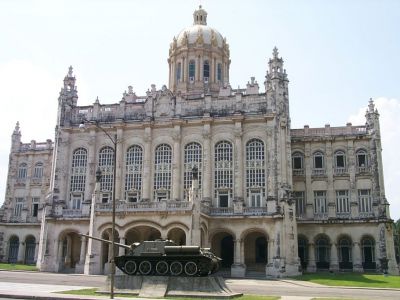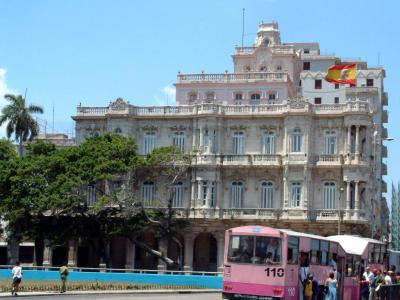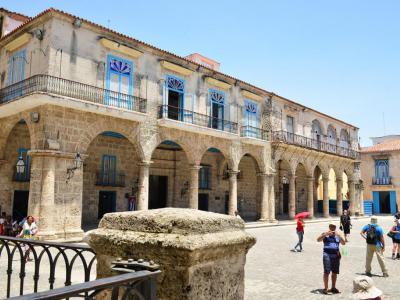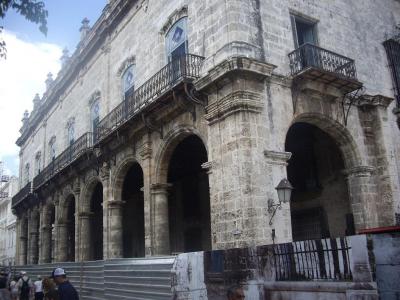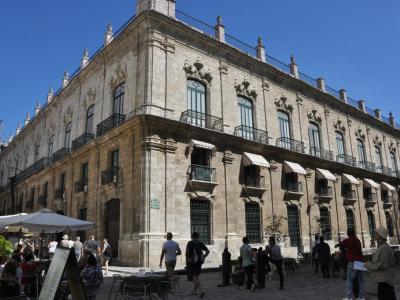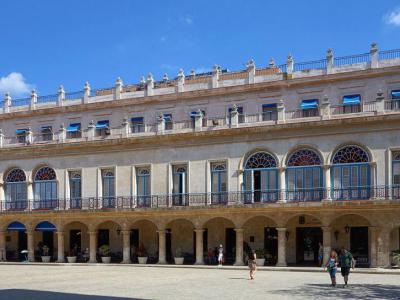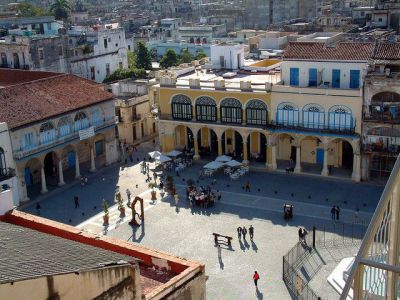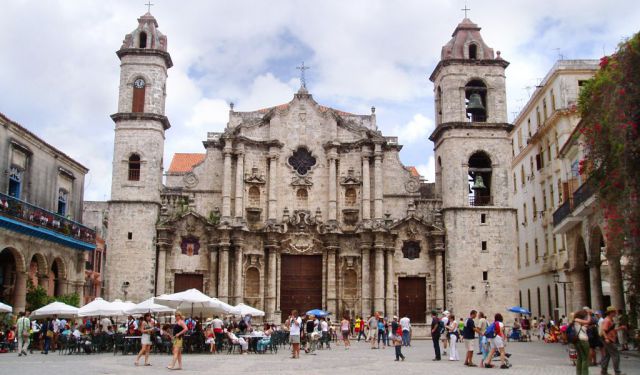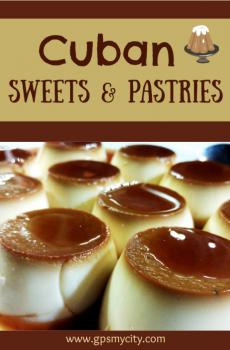
Old Palaces Walking Tour (Self Guided), Havana
Havana has been the seat of Cuba’s ruling gentry for centuries. Today, you can walk the streets of Old Havana and explore its palaces to get a glimpse into the city’s royal past. Although these structures now serve Havana’s citizens and visitors, they still catch your eye (and your camera lens!) with their architecture and history.
Start your trip with the ornate Presidential Palace, whose interior decoration was entrusted in the 1920s to Tiffany’s of New York. Following the Cuban Revolution, the three-story palace was converted into a museum still commemorating the event.
The somber yet stately Palace of the Captains-Generals was completed in 1791 and became the early seat of the Cuban government, as well as Havana’s city hall. Now housing the City of Havana Museum, the structure contains the breathtaking Throne Room, made for the king of Spain but never used, as well as a statue of Christopher Columbus in its courtyard.
Don’t miss the quintessentially Cuban-colonial facade of Palacio del Conde de Santovenia, which boasts large stained-glass windows called ‘mediopuntos’.
To ensure your trips ends on a high note, visit the distinctive Palacio Cueto – Havana's finest example of Art Nouveau, dating from the early 1900s.
Take this self-guided walk and find out why Havana's palaces are one of the greatest cultural legacies that the Spanish Empire left in Cuba!
Start your trip with the ornate Presidential Palace, whose interior decoration was entrusted in the 1920s to Tiffany’s of New York. Following the Cuban Revolution, the three-story palace was converted into a museum still commemorating the event.
The somber yet stately Palace of the Captains-Generals was completed in 1791 and became the early seat of the Cuban government, as well as Havana’s city hall. Now housing the City of Havana Museum, the structure contains the breathtaking Throne Room, made for the king of Spain but never used, as well as a statue of Christopher Columbus in its courtyard.
Don’t miss the quintessentially Cuban-colonial facade of Palacio del Conde de Santovenia, which boasts large stained-glass windows called ‘mediopuntos’.
To ensure your trips ends on a high note, visit the distinctive Palacio Cueto – Havana's finest example of Art Nouveau, dating from the early 1900s.
Take this self-guided walk and find out why Havana's palaces are one of the greatest cultural legacies that the Spanish Empire left in Cuba!
How it works: Download the app "GPSmyCity: Walks in 1K+ Cities" from Apple App Store or Google Play Store to your mobile phone or tablet. The app turns your mobile device into a personal tour guide and its built-in GPS navigation functions guide you from one tour stop to next. The app works offline, so no data plan is needed when traveling abroad.
Old Palaces Walking Tour Map
Guide Name: Old Palaces Walking Tour
Guide Location: Cuba » Havana (See other walking tours in Havana)
Guide Type: Self-guided Walking Tour (Sightseeing)
# of Attractions: 7
Tour Duration: 1 Hour(s)
Travel Distance: 2.1 Km or 1.3 Miles
Author: kane
Sight(s) Featured in This Guide:
Guide Location: Cuba » Havana (See other walking tours in Havana)
Guide Type: Self-guided Walking Tour (Sightseeing)
# of Attractions: 7
Tour Duration: 1 Hour(s)
Travel Distance: 2.1 Km or 1.3 Miles
Author: kane
Sight(s) Featured in This Guide:
- Presidential Palace / Museum of the Revolution
- Spanish Embassy (former Velasco-Sarra Palace)
- Palacio del Conde de Lombillo (Palace of the Count of Lombillo)
- Palacio del Segundo Cabo (Palace of the Second Lieutenant)
- Palace of the Captains-Generals / Havana City Museum
- Palacio del Conde de Santovenia (Palace of the Count of Santovenia )
- Palacio Cueto (Cueto Palace)
1) Presidential Palace / Museum of the Revolution
The Museum of the Revolution (Museo de la Revolución) is housed in what was the "Presidential Palace" of all Cuban presidents from Mario García Menocal to Fulgencio Batista. The building was the site of the Havana Presidential Palace Attack (1957) by the Directorio Revolucionario Estudiantil, and became a museum during the years following the Cuban Revolution of 1959.
The palace was designed by Cuban architect Carlos Maruri and Belgian architect Paul Belau (who also designed the Centro Gallego, presently the Gran Teatro de La Habana) and was inaugurated in 1920 by President Mario García Menocal. The building has Neo-Classical elements and was decorated by Tiffany Studios of New York City.
The museum's Cuban history exhibits are largely devoted to the period of the revolutionary war of the 1950s and to the country's post-1959 history. Portions of the museum are also devoted to pre-revolutionary Cuba, including the 1895-1898 War of Independence waged against Spain.
Why You Should Visit:
To get a well-done history lesson on the Cuban Revolution. Basic displays (photos, uniforms) are laid out chronologically with reasonable English descriptions. Admission also includes the "Granma" yacht and some of the vehicles used during the Revolution and in the different crises that arose in the '60s.
The building itself is very grand and an important part of Cuban history, which alone makes it worth the visit. Highlights include the Salón de los Espejos – a replica of the Hall of Mirrors in the Palace of Versailles or the Salón Dorado (Golden Hall) which is made of yellow marble.
Tip:
Go early, wear good walking shoes and be discreet with your cell phone.
Be sure to go to the old ballroom and step out on the balcony for great views of the harbor.
The palace was designed by Cuban architect Carlos Maruri and Belgian architect Paul Belau (who also designed the Centro Gallego, presently the Gran Teatro de La Habana) and was inaugurated in 1920 by President Mario García Menocal. The building has Neo-Classical elements and was decorated by Tiffany Studios of New York City.
The museum's Cuban history exhibits are largely devoted to the period of the revolutionary war of the 1950s and to the country's post-1959 history. Portions of the museum are also devoted to pre-revolutionary Cuba, including the 1895-1898 War of Independence waged against Spain.
Why You Should Visit:
To get a well-done history lesson on the Cuban Revolution. Basic displays (photos, uniforms) are laid out chronologically with reasonable English descriptions. Admission also includes the "Granma" yacht and some of the vehicles used during the Revolution and in the different crises that arose in the '60s.
The building itself is very grand and an important part of Cuban history, which alone makes it worth the visit. Highlights include the Salón de los Espejos – a replica of the Hall of Mirrors in the Palace of Versailles or the Salón Dorado (Golden Hall) which is made of yellow marble.
Tip:
Go early, wear good walking shoes and be discreet with your cell phone.
Be sure to go to the old ballroom and step out on the balcony for great views of the harbor.
2) Spanish Embassy (former Velasco-Sarra Palace)
The Spanish Embassy in Havana, situated near the Presidential Palace, is an architectural gem housed in what was once known as the Velasco-Sarra Palace. This remarkable building is a testament to the Art Nouveau movement of the early 20th century, designed by the architects Jose Mato Sequeiro and Francisco Ramirez Ovando in 1912. Initially, it was a grand gesture from Ernesto Sarra to his sister Maria Teresa on her marriage to Dionisio Velasco, symbolizing the prosperity and success of the Sarra family's pharmaceutical enterprise, which emerged as a leading business in Latin America and held significant global standing.
The Velasco-Sarra Palace, with its exquisite Art Nouveau design, is noted for its ornamental richness and architectural finesse. The structure showcases an array of decorative elements, including grand arches on the first floor and intricate bas relief statues adorning the building's corners. The presence of expansive balconies for each window on the second and third floors adds to its grandeur, enhancing its visibility and beauty, particularly when illuminated at night.
After remaining with the Velasco family until 1960, the palace transitioned to a new role, first serving as the Commercial Office of the Spanish Embassy and later, in the 1980s, becoming the Spanish Embassy itself. Its transformation over the years has not detracted from its architectural splendor; rather, it has added layers to its historical and cultural significance.
The palace's strategic location facing Havana's bay entrance amplifies its allure, making it a prominent and distinguished landmark, especially when its unique contours are highlighted against the night sky. The Spanish Embassy, as it stands today, continues to be an integral piece of Havana's rich architectural tapestry, embodying a blend of historical legacy and aesthetic grandeur.
The Velasco-Sarra Palace, with its exquisite Art Nouveau design, is noted for its ornamental richness and architectural finesse. The structure showcases an array of decorative elements, including grand arches on the first floor and intricate bas relief statues adorning the building's corners. The presence of expansive balconies for each window on the second and third floors adds to its grandeur, enhancing its visibility and beauty, particularly when illuminated at night.
After remaining with the Velasco family until 1960, the palace transitioned to a new role, first serving as the Commercial Office of the Spanish Embassy and later, in the 1980s, becoming the Spanish Embassy itself. Its transformation over the years has not detracted from its architectural splendor; rather, it has added layers to its historical and cultural significance.
The palace's strategic location facing Havana's bay entrance amplifies its allure, making it a prominent and distinguished landmark, especially when its unique contours are highlighted against the night sky. The Spanish Embassy, as it stands today, continues to be an integral piece of Havana's rich architectural tapestry, embodying a blend of historical legacy and aesthetic grandeur.
3) Palacio del Conde de Lombillo (Palace of the Count of Lombillo)
Built in 1741, this palace is located right next to the Catedral de San Cristóbal de La Habana, in Old Havana, complementing the extraordinary set of colonial buildings in the Cathedral Square. It's a typical large colonial house that was inhabited by descendants of the first settlers of Havana, the Pedroso family, but the building takes its name from Count Lombillo who married to one of the family's descendants at the end of the 19th century. During 300 years it was submitted to remodeling and additions up to its precious current condition.
Remarkable lawyers like Doctor Ricardo Dolz, the Escuela Municipal de Música (Municipal School of Music) or the secretaría de la Defensa Nacional (National Defense Secretary) found their place in this magnificent palace. In the past, it also served as a post office and as a Museo de Pedagogía Cubana (Museum of Cuban Pedagogy). From 1947, it was the headquarters of the Archivo Histórico Municipal Habanero (Havana Municipal Historical Archive), the Biblioteca Histórica Cubana y Americana (Cuban and American Historical Library), the el Museo de la Ciudad de la Habana y las Publicaciones (Museum of the City of Havana and the Publications). At present, it is completely restored and has once again become the headquarters of the Office of the Historian of Old Havana.
Remarkable lawyers like Doctor Ricardo Dolz, the Escuela Municipal de Música (Municipal School of Music) or the secretaría de la Defensa Nacional (National Defense Secretary) found their place in this magnificent palace. In the past, it also served as a post office and as a Museo de Pedagogía Cubana (Museum of Cuban Pedagogy). From 1947, it was the headquarters of the Archivo Histórico Municipal Habanero (Havana Municipal Historical Archive), the Biblioteca Histórica Cubana y Americana (Cuban and American Historical Library), the el Museo de la Ciudad de la Habana y las Publicaciones (Museum of the City of Havana and the Publications). At present, it is completely restored and has once again become the headquarters of the Office of the Historian of Old Havana.
4) Palacio del Segundo Cabo (Palace of the Second Lieutenant)
The Palace of the Second Lieutenant (Palacio del Segundo Cabo) in Havana, holds a historical and cultural position, reflecting a rich past that transitions into a dynamic present. Erected around 1770 initially as the city's post office, the building's role evolved substantially over the centuries. It served as the headquarters for the Spanish vice governor-general and, following Cuban independence, transitioned to become the seat of the Senate.
In 2016, the palace embarked on a new chapter, reopening as a Center for Interpretation of Cultural Relations between Cuba and Europe. This transformation marked its significance not only as a historical monument but also as a beacon of cultural exchange and understanding. The palace's baroque architectural style is particularly noteworthy, with a courtyard celebrated for its intricate and stunning details.
As a cultural center, the palace now offers an immersive experience that melds historical charm with modern technology. Visitors can explore a variety of interactive exhibits spread across two floors, which together illuminate the intertwined histories and cultural dialogues between Cuba and Europe. The exhibition includes a timeline tunnel, cube-activated screens showcasing different aspects of Cuban history, an exploration of Cuban-European musical traditions, and a study comparing the architectural evolution of Havana and Barcelona.
These features, supported by EU funding, underscore the center's status as a premier educational and cultural institution in Havana. The blend of traditional and contemporary elements, alongside the in-depth exploration of Cuban and European connections, makes the Palace of the Second Lieutenant a standout museum, offering unique insights and a memorable experience to its visitors.
In 2016, the palace embarked on a new chapter, reopening as a Center for Interpretation of Cultural Relations between Cuba and Europe. This transformation marked its significance not only as a historical monument but also as a beacon of cultural exchange and understanding. The palace's baroque architectural style is particularly noteworthy, with a courtyard celebrated for its intricate and stunning details.
As a cultural center, the palace now offers an immersive experience that melds historical charm with modern technology. Visitors can explore a variety of interactive exhibits spread across two floors, which together illuminate the intertwined histories and cultural dialogues between Cuba and Europe. The exhibition includes a timeline tunnel, cube-activated screens showcasing different aspects of Cuban history, an exploration of Cuban-European musical traditions, and a study comparing the architectural evolution of Havana and Barcelona.
These features, supported by EU funding, underscore the center's status as a premier educational and cultural institution in Havana. The blend of traditional and contemporary elements, alongside the in-depth exploration of Cuban and European connections, makes the Palace of the Second Lieutenant a standout museum, offering unique insights and a memorable experience to its visitors.
5) Palace of the Captains-Generals / Havana City Museum
The Museum of the City of Havana is housed in the old Palace of the Captains General (Palacio de los Capitanes Generales), a prominent Cuban Baroque-style mansion that occupies the entire western side of the Main Square (Plaza de Armas) in Havana. Constructed in the 1770s, this grand edifice served as the residence for the Spanish governors of Havana and later transitioned to the city's town hall in the post-colonial era. Its architectural significance and historical relevance have earned a place within the UNESCO World Heritage Site designation for "Old Havana and its Fortification System."
The Palace's design is quintessentially Cuban Baroque, characterized by thick walls, an arcade with arches supported by columns, and floors made of a distinctive paving material. The first story features a limestone façade, sourced locally and embedded with marine fossils, showcasing small balconies and stained-glass windows that align with the columns below. The courtyard, adorned with trees and peacocks, features a white marble statue of Christopher Columbus dating back to 1862.
Inside, the museum's ground floor and mezzanine display a collection of art and artifacts that narrate Havana's storied past. Among its treasures are the "La Giradilla" statue, the Cenotaph from the Parroquial Mayor Church, and relics from the Espada Cemetery, including Jean Baptiste Vermay's tomb.
The museum's exhibits extend to a range of subjects, reflecting on Cuba's historical narrative through antique furniture, photography, horse-drawn carriages, and military attire. Notably, it houses Cuba's inaugural flag and the boat used by Antonio Maceo in 1896. The Salón del Trono, or Throne Room, is another highlight, showcasing a throne that was prepared for an anticipated royal visit from the King of Spain that never transpired.
Tip:
Make sure that you buy a ticket that shows all the exhibits.
The Palace's design is quintessentially Cuban Baroque, characterized by thick walls, an arcade with arches supported by columns, and floors made of a distinctive paving material. The first story features a limestone façade, sourced locally and embedded with marine fossils, showcasing small balconies and stained-glass windows that align with the columns below. The courtyard, adorned with trees and peacocks, features a white marble statue of Christopher Columbus dating back to 1862.
Inside, the museum's ground floor and mezzanine display a collection of art and artifacts that narrate Havana's storied past. Among its treasures are the "La Giradilla" statue, the Cenotaph from the Parroquial Mayor Church, and relics from the Espada Cemetery, including Jean Baptiste Vermay's tomb.
The museum's exhibits extend to a range of subjects, reflecting on Cuba's historical narrative through antique furniture, photography, horse-drawn carriages, and military attire. Notably, it houses Cuba's inaugural flag and the boat used by Antonio Maceo in 1896. The Salón del Trono, or Throne Room, is another highlight, showcasing a throne that was prepared for an anticipated royal visit from the King of Spain that never transpired.
Tip:
Make sure that you buy a ticket that shows all the exhibits.
6) Palacio del Conde de Santovenia (Palace of the Count of Santovenia )
The Palace of the Count of Santovenia (Palacio del Conde de Santovenia), has a storied history that traces back to the early 19th century. Initially celebrated for its advantageous position that facilitated a cool sea breeze from the Bay, the palace was a cultural hub, notably during holidays when the count permitted the Military Band to perform on its roof for the public in the Main Square (Plaza de Armas).
After the death of the count and the departure of his heirs to Spain in 1866, the property transitioned hands to Colonel Luis Lay, an American from New Orleans, who transformed it into the prestigious Hotel Santa Isabel, relocating it from its previous address on Habana Street. Lay's modifications positioned the hotel as one of the most significant and modern accommodations in Cuba at the time.
The transformation into a hotel marked a new era for the building, capturing the essence of Havana's affluent society. The upper floors, once the private quarters of the counts, boasted elegant furnishings and decor, while the ground level served commercial purposes. The address, Baratillo No. 9, later became the site for the Havana Food Market in 1888, further cementing its place in Havana's commercial and social landscape.
In 1943, a comprehensive renovation was undertaken to preserve its architectural integrity, transitioning it for office use. Following the 1959 Cuban Revolution, the building was nationalized, serving various functions until it became a restaurant in the 1980s, which did not prevent its gradual decline.
Recognizing the building's historical and cultural value, the Office of the Historian of Havana initiated a full restoration in the mid-1990s, culminating in the 1997 reopening of the Hotel Santa Isabel. This restoration revitalized the palace as a luxury hotel, showcasing its original architectural features within a quintessentially colonial mansion ambiance, thus preserving an important piece of Havana's heritage.
After the death of the count and the departure of his heirs to Spain in 1866, the property transitioned hands to Colonel Luis Lay, an American from New Orleans, who transformed it into the prestigious Hotel Santa Isabel, relocating it from its previous address on Habana Street. Lay's modifications positioned the hotel as one of the most significant and modern accommodations in Cuba at the time.
The transformation into a hotel marked a new era for the building, capturing the essence of Havana's affluent society. The upper floors, once the private quarters of the counts, boasted elegant furnishings and decor, while the ground level served commercial purposes. The address, Baratillo No. 9, later became the site for the Havana Food Market in 1888, further cementing its place in Havana's commercial and social landscape.
In 1943, a comprehensive renovation was undertaken to preserve its architectural integrity, transitioning it for office use. Following the 1959 Cuban Revolution, the building was nationalized, serving various functions until it became a restaurant in the 1980s, which did not prevent its gradual decline.
Recognizing the building's historical and cultural value, the Office of the Historian of Havana initiated a full restoration in the mid-1990s, culminating in the 1997 reopening of the Hotel Santa Isabel. This restoration revitalized the palace as a luxury hotel, showcasing its original architectural features within a quintessentially colonial mansion ambiance, thus preserving an important piece of Havana's heritage.
7) Palacio Cueto (Cueto Palace)
Cueto Palace (Palacio Cueto), situated in Havana, showcases remarkable Art Nouveau architecture and is hailed as one of Arturo Márquez's finest architectural accomplishments. Built in 1906, this structure impresses with its Gaudí-inspired adornments, featuring a facade adorned with intricate details depicting mythical creatures like griffins and satyrs, distinguishing it amidst Havana's cityscape.
Initially intended as a storage facility and hat factory, the building was transformed in the 1920s overseen by José Cueto, evolving into the Vienna Palace Hotel (Palacio Viena Hotel). Later renovations repurposed it into an apartment complex. Presently, managed by the City Historian’s Office, Cueto Palace is undergoing restoration to become a luxury hotel with 57 rooms.
This architectural marvel embodies the expressionist style prominent in the early 20th century and is officially classified as modern. Architectural experts speculate that Marqués drew inspiration from emerging European trends of the era. The hotel's highlight is its spectacular rooftop terrace, complete with a small tower, offering stunning panoramic views of historic Havana. Cueto Palace serves as a testament to the fusion of art, history, and architectural creativity, inviting visitors to delve into its rich heritage and enduring elegance.
Initially intended as a storage facility and hat factory, the building was transformed in the 1920s overseen by José Cueto, evolving into the Vienna Palace Hotel (Palacio Viena Hotel). Later renovations repurposed it into an apartment complex. Presently, managed by the City Historian’s Office, Cueto Palace is undergoing restoration to become a luxury hotel with 57 rooms.
This architectural marvel embodies the expressionist style prominent in the early 20th century and is officially classified as modern. Architectural experts speculate that Marqués drew inspiration from emerging European trends of the era. The hotel's highlight is its spectacular rooftop terrace, complete with a small tower, offering stunning panoramic views of historic Havana. Cueto Palace serves as a testament to the fusion of art, history, and architectural creativity, inviting visitors to delve into its rich heritage and enduring elegance.
Walking Tours in Havana, Cuba
Create Your Own Walk in Havana
Creating your own self-guided walk in Havana is easy and fun. Choose the city attractions that you want to see and a walk route map will be created just for you. You can even set your hotel as the start point of the walk.
Old Town Walking Tour
The Spanish founded Havana in 1519. After French pirate Jacques de Sores ransacked the city in 1555, the Castle of the Royal Force was built to protect the city.
Havana became a major stopping point between the newly discovered Americas and ancient Europe. In the 1600s, Havana was a major shipbuilding port.
Old Havana is listed as a UNESCO World Heritage Site. The historic city has five... view more
Tour Duration: 2 Hour(s)
Travel Distance: 2.7 Km or 1.7 Miles
Havana became a major stopping point between the newly discovered Americas and ancient Europe. In the 1600s, Havana was a major shipbuilding port.
Old Havana is listed as a UNESCO World Heritage Site. The historic city has five... view more
Tour Duration: 2 Hour(s)
Travel Distance: 2.7 Km or 1.7 Miles
Hemingway's Havana Walking Tour
Ever since Hemingway first visited Cuba in 1928 until his death in 1961, he felt an intense connection with the people and culture of Cuba. Hemingway lived at Hotel Ambos Mundos during the 1930s, and began, wrote, and finished several novels there. Today, you can see some of Hemingway's belongings in Room 511.
Hemingway was a frequent patron at El Floridita, famous for its daiquiris.... view more
Tour Duration: 1 Hour(s)
Travel Distance: 1.1 Km or 0.7 Miles
Hemingway was a frequent patron at El Floridita, famous for its daiquiris.... view more
Tour Duration: 1 Hour(s)
Travel Distance: 1.1 Km or 0.7 Miles
Historical Churches and Cathedrals Walking Tour
Discovered and conquered by Spanish colonists in the early 16th century, Havana has turned into a major religious center of Catholicism in the Caribbean. Although a communist regime is currently in power, many of the churches, cathedrals, and other religious buildings have been preserved and still give a glimpse of the city’s religious heritage.
The old Havana Cathedral, located in a... view more
Tour Duration: 2 Hour(s)
Travel Distance: 3.1 Km or 1.9 Miles
The old Havana Cathedral, located in a... view more
Tour Duration: 2 Hour(s)
Travel Distance: 3.1 Km or 1.9 Miles
Useful Travel Guides for Planning Your Trip
Cuban Sweets and Pastries
On the tropical island where sugar cane is one of the main commodities along with the rum made of the very same sugar, and where the enormous abundance of tropical fruits make up a great deal of the local diet, it is only natural to expect the richness of dessert cuisine. Pair it with the strong...
18 Uniquely Cuban Things to Buy in Havana
Rum, cigars and revolution have been, perhaps, at least until recently, the three most popular exports from Cuba. Luckily, with the embargo lifted (or soon to be lifted), those traveling to the U.S. might soon be able to pick up some of these (with the exception of revolution, perhaps) on their way...
The Most Popular Cities
/ view all
